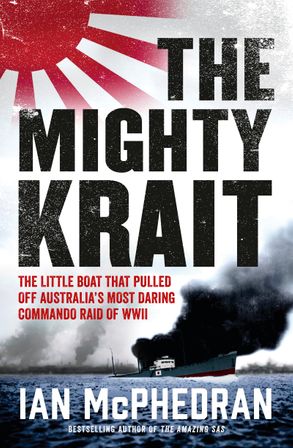Ian McPhedran has subtitled this book ‘The Little Boat That Pulled Off Australia’s Most Daring Commando Raid of WWII’ to alert readers that this is more than another book about Operation ‘Jaywick’. Timed to coincide with its 75th anniversary, this is the story of the commando raid on shipping at Singapore in 1943.

Paperback 244pp RRP $35.00
Krait began life as Kohfuku Maru, a Japanese copy of a British drifter, and was berthed in Singapore when Japan declared war in 1941. Quickly refitted through the efforts of Australian master mariner Bill Reynolds she escaped from Singapore with refugees and, under the Chinese flag as Suey Sin Fah, made her way to Ceylon and then India. From India, and now named Krait. the boat was transported to Australia as deck cargo and subsequently used in the Special Operations Executive and Australian commanded Operation “Jaywick”.
Operation ‘Jaywick’ is described in detail, with two excellent maps that enable the approach and return from Singapore to be followed without recourse to an inadequate atlas. The disastrous Operation “Rimau”, which led to the deaths of all but one of the “Jaywick” force is also mentioned. A historian might be satisfied at this point, but Ian McPhedran has devoted the final chapters to ‘saving the Krait’, thus making the book interesting reading for small boat sailors and shipwrights.
Transferred to Special Operations Australia after “Jaywick”, Krait was assigned to the Timor Ferry Service, paid off in 1945 and spent the next two decades as MV Pedang, a workboat in the Borneo timber industry. Worn out by this service, Pedang was fortunate not to be broken up, but was discovered and purchased by the Z Special Unit Association in 1963 and shipped back to Australia.
Renamed once again as Krait, she was refitted and turned over to the Royal Volunteer Coastal Patrol to be used as a training vessel. By 1980, however, it was apparent that her hull had deteriorated, and Krait was sailed to Ballina for a major refit. After this refit she returned to Sydney while her future role was determined.
It would spoil the suspense for the reviewer to complete the story of saving Krait, if indeed it has been completed, but the final chapters of the book cover the questions of whether the Australian War Memorial or the Australian National Maritime Museum should be her owner, where Krait should be located and whether she should remain afloat or be preserved out of the water. The 2017 – 2018 restoration is of interest to all those who love wooden boats.
The Mighty Krait has a useful glossary and an index and is recommended reading for both military historians and those who love boats.
Reviewed for RUSIV by Roger Buxton, September 2019
Contact Royal United Services Institute about this article.






